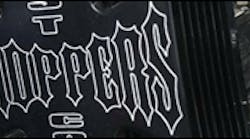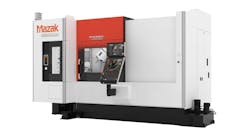Jesse James, owner of West Coast Choppers (WCC) and star of TV’s
Monster Garage, sculpts two-wheeled works of art for Shaquille O’Neal, Kid Rock, Keanu Reeves, and anyone else willing to pay $50,000 to $150,000 for one of his creations. Each bike takes 500 to 800 man hours to build -- and all parts are manufactured in-house to James’ exacting standards. This calls for a skillful blending of old-world metalworking and high-precision CNC machining.
“Every part on our bikes that isn’t hand fabricated is CNC machined,” says James. “All the brackets, all the engine mounts, everything. It’s more expensive to do it that way, but the quality’s better. It makes a better end product. I think a bike should be 50% programmed and 50% made by hand. If you can blend that mix, it’s perfect.”
James is hands-on when it comes to building custom bikes and designing new products. “People are paying a premium price for a Jesse James bike,” he explains. “Jesse James should be making some of it, right? I’ve got a whole row of bikes lined up and waiting for me to make tanks and fenders and exhaust systems for them.”
Not everything WCC produces is custom, though. The company also manufactures three production frames, several exhaust systems, an assortment of front and rear fenders, and aftermarket accessories, such as air cleaners, belt guards, pulley covers, kickstands, and handlebars.
Machined or hand-crafted? James doesn’t like his machined parts to look machined. He wants them to appear as if they’re sculpted out of metal, with smooth curves and complex shapes, and polished to a mirror shine. That’s where the engineering skills of CNC programmer Michael Warth come into play. “What we do mixes my skills,” says James, “which are predominantly as a fabricator, with Mike’s skills as a CNC guy, and blends them together.”
Warth is a skilled machinist with 18 yr of experience running machines, and 12 yr of experience programming them. His background is predominantly aerospace work, with a heavy emphasis on 5-axis work.
“I try to get as close as I can between the artistic approach and the realistic approach,” says Warth. “I have to bring the two things together and merge them into one.”
Just because something looks good on paper, though, doesn’t mean it will work in the real world -- the laws of physics still apply. “If it’s not strong enough,” says Warth, “it will buckle and fold if we put it on a bike.”
Warth’s job is to ensure that doesn’t happen. But James is always pushing the envelope, and hence Warth, with his designs and with what he wants to do with the machines. One recent project was machining some special wheels: “They’re carved from a solid aluminum block,” says James. “Fifty-eight hours of machine time.”
At the time, WCC didn’t have the machining capability to turn the large chunks of aluminum, so it sent out the material for the lathe work. The results were disastrous. “We started with two sets of material, enough for front and rear wheels for two bikes, and they messed up both of the front wheels, and they didn’t tell us,” says Warth. “They blew the lathe work, and then laid this weld bead all the way around and re-machined it. When we had the wheels anodized, it showed up.”
Considering the wheels were for a prototype concept bike for Honda, James was not pleased. He told Warth to find a machine that would allow them to do the wheels completely in-house.
The company, which already owned two VMCs and a turning center from Haas Automation Inc., Oxnard, Calif., added a Haas VTC-48 vertical turning center to the mix.
Machining full throttle The machining processes for the wheels differ slightly, depending on whether it’s a front or a rear wheel. The rear wheel starts out as a 550-lb block of aluminum, and the material for the front wheel weighs in at about 330 pounds. The finished weight of the rear is about 58 lb, and the front comes in around 48 lb.
The front wheel is by far the easier of the two to machine. Everything is done using the 50-taper live tooling on the VTC. “Because I don’t have to go that deep,” Warth explains, “I can use the live tooling and machine it into a round.”
For the rear wheel, Warth deals with 11.5-in. stock. “Try to mill 11.5-in. deep. It doesn’t work too well,” he comments. “So I turn the rear wheel; I come in with an O.D. turning tool, and turn it down to the diameter I want. It takes a hundred steps to get there -- 200 rpm, five thou’ per rev. It takes a day, a day and a half, just to do the rough turning.” The wheels are rough machined first, and then sent out for heat-treatment and stress-relief. Then they’re finish machined and polished.
Cycle times are measured in days, rather than hours. “The rear wheel -- to machine one complete out of square material -- takes about 8 days on the machine,” says Warth. “The front wheel takes about 5 days.”
Although the VTC is a turning center, Warth prefers to use a mill post-processor for his programming. He makes extensive use of the Cartesian-to-polar interpolation feature of the Haas control. “It converts a standard X, Y program into X and rotary,” he explains. “It converts it on-the-fly in the machine; I run that all the time.”
Don’t expect to see a production version of the billet wheels any time soon, though. James has no interest in high-volume manufacturing. “We make a few sets of each style, and then go on to something else,” James says. “I want to keep them cool, so I only make a couple of them. It just separates us that much farther. There’s not too many shops that are going to put $25,000 wheels on a bike . . . but I will.”
| On the ride of his life Jesse James plays by his own rules. Lately, this tough-guy welder has gotten lots of attention, thanks in large part to his gig as frontman for the Discovery Channel’s hit series Monster Garage. His custom bikes have made him a legend as well. Currently, his company, West Coast Choppers, rakes in an estimated $6 million in annual revenues – 60% of which is generated by the company’s clothing line. Despite his popularity, though, James still considers himself “a glorified welder.” West Coast Choppers became a reality in 1992, and it wasn’t long before James couldn’t fit everything in his garage anymore. As WCC continued to grow, James employed a simple business plan: work hard and pump every dime back into the company. “Whenever I sold a bike,” he says, “I took the profit and put it back into the business, or bought another sheet metal machine, or tooling, or whatever.” Those investments paid off. West Coast Choppers developed a loyal following of fans and customers, and James’ bikes started getting serious play in the biker magazines. But it wasn’t until 2001 that James got his first mainstream exposure, when the Discovery Channel aired a pair of specials – Motorcycle Mania I and Motorcycle Mania I. It was the world’s first glimpse of this modern-day outlaw, and apparently the world liked what it saw. The extreme popularity of those shows, in turn, led to James’ current stint hosting Monster Garage. |
Latest from Machining / Cutting
Latest from Machining / Cutting
April 2, 2025
March 26, 2025
March 11, 2025
March 5, 2025
Jan. 7, 2025







